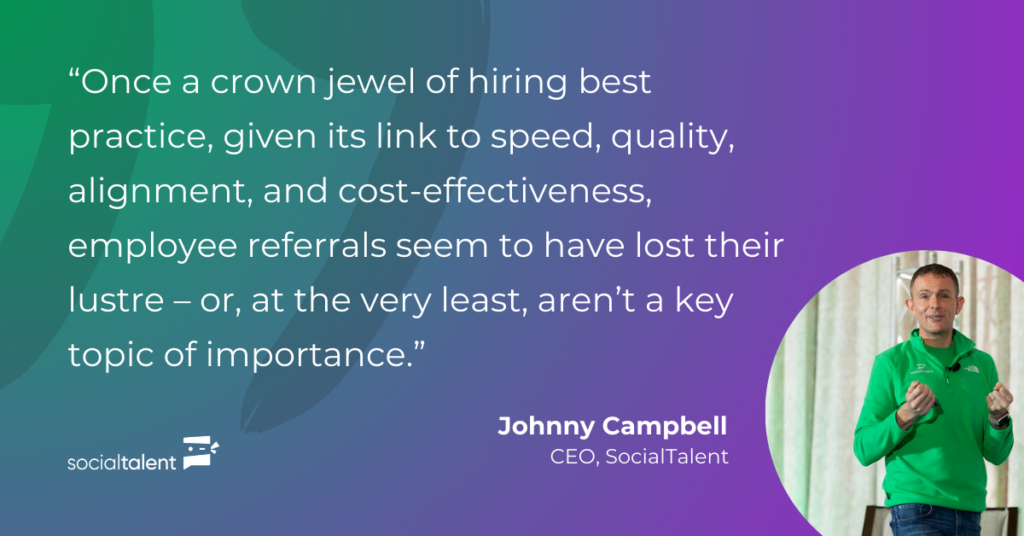What the Hell Has Happened to Employee Referrals?
One of the greatest things about being on the road again, going to events and meeting clients, customers, and friends within the industry, is getting the chance to chat about what is truly happening on the ground with recruiting in 2024.
We can read articles or listen to podcasts that wax lyrical about the common challenges that the talent world is facing, but nothing beats hearing it from the horse’s mouth. And it was during one of these illuminating conversations that I was struck with a sudden realization:
What the hell has happened to employee referrals?
As TA teams struggle to find the talent that is needed to drive success in a sustainable and effective manner, I found it odd that no-one really seemed to be talking about employee referrals as a strategic option anymore. Once a crown jewel of hiring best practice, given its link to speed, quality, alignment, and cost-effectiveness, employee referrals seem to have lost their lustre – or, at the very least, aren’t a key topic of importance.
So I tested the theory. I asked some clients about it specifically, and they largely confirmed my suspicions. Pressure to achieve employee referrals was indeed down – and in one particular instance, referral rates themselves had dropped by over 80% in the last couple of years.
It blew my mind. And there were only two things I could think of that could be causing this phenomenon: Low attrition and poor employee engagement.
1. Low Attrition Levels
It’s no secret that attrition levels are very low right now. I was only recently reading Dan Shapero’s article on LinkedIn about this where he said that:
“Employees have largely sheltered in place, reluctant to make a move due to the softened economy, and the vast majority of companies are seeing very low employee turnover as a result.”
Retention just isn’t a high-priority issue on the agenda, and without attrition (and even healthy attrition at that), there is less and less need for a thriving employee referral program. Fewer job openings ultimately means fewer opportunities for referrals – and as staff stay longer and longer, networks can often stagnate and diminish, thus reducing the pool, even if there is need for it.
2. Employee Engagement
Employees may not be leaving their jobs, but that certainly doesn’t mean they’re happy. I find that retention is often misaligned with engagement, but they are two very different parameters. Just because an employee is staying in a role, it doesn’t mean they’re actually content.
Gallup’s latest “State of the Workplace” report seems to confirm this – employee engagement remains at a dismal 23% for the second year in a row, bucking the positive incline from the last two years.
In an atmosphere of discontent, employees aren’t going to extend invites to their network to join a company they perceive as negative. And if Dan’s article is correct, and a Great Reshuffle is soon to be on the cards, it also seems like these disengaged employees are only biding their time to jump ship themselves. Could this be another reason why referrals may have declined?

The Future of Employee Referrals
According to Smart Recruiters’ “Tactics & Strategies for Winning Hard-to-Find Talent” survey, employee referrals are listed as the most effective sourcing and engagement channels for finding candidates with specialized skill sets. However, in the same report, employee referrals are also listed as a challenge, in that getting an adequate number is currently a big struggle for recruiters.
It’s interesting to see a dichotomy like this. It seems that while employee referrals are tagged as still vital, they are also a dwindling resource and are in short supply – perhaps because of low engagement levels?
I do still think employee referrals are an integral part of a high-functioning hiring ecosystem and are an important cog in the machine of finding key talent. And I also think that this situation may only be a blip in the matrix!
There is no movement in the market right now, but this is set to change by the end of the year. As interest rates drop and capital to invest becomes more readily available (and not to mention, when the US election is decided), attrition will rise once again and employee referrals will be on every talent acquisition professional’s radar.
But is this short sighted? Are we wrong to just ignore this now while the state of affairs is in flux? Building a healthy employee referral system takes concerted effort and it may be too late by the time recruiters actually need it.
More Conversations Needed
I’ve asked a lot of questions in this article because I’d like this to be a catalyst for further conversation. I want to hear your thoughts about this. What are your employee referral levels like? Are they down? Does your business care? Why are so few people talking about this?
Maybe my hypothesis is completely wrong. Maybe in some sectorars and businesses employee referrals are still a thriving source of top talent, but I’d love to get a more holistic view.
It does feel like employees are dissatisfied right now – compelled to stay in place due to forces outside of their control, and perhaps this is an even bigger cause for concern?
